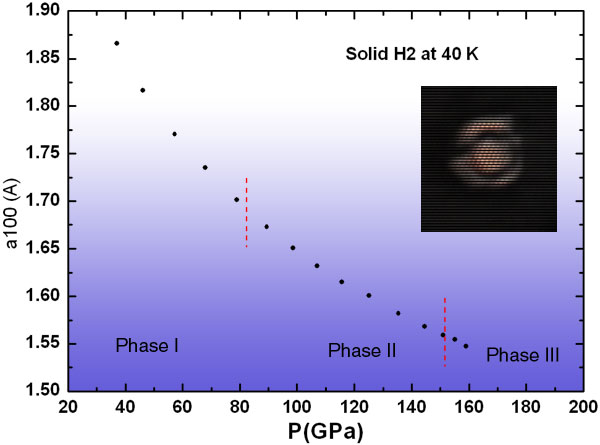- Home
- News
- Spotlight on Science
- First Data on the...
First Data on the Structure of Phase III of Hydrogen Above 150 GPa
25-09-2006
Knowing the structure of solid hydrogen at very high pressure is essential to progress towards the discovery of metal hydrogen. Using the combination of the new specialised high-pressure beamline and the compression of a single crystal of H2 in helium allow the first X-ray data of the very high pressure phase of hydrogen.
Share
From spectroscopic measurements up to 350 GPa, it is known that solid hydrogen exists in three crystallographic forms: a close packed lattice of freely-rotating molecules (phase I); an incommensurate structure with a local orientational order due to a quantum orientational transition, as recently solved by a combination of X-ray and neutron diffraction [1] (phase II), and furthermore, above 150 GPa, phase III, which is stable up to at least 320 GPa. The determination of the structure of this phase is crucial for understanding the metallisation of hydrogen but constitutes a great experimental challenge due to the extremely weak scattering power of the solid hydrogen sample under such extreme conditions.
A recent experiment at the ESRF beamline ID27 (Loubeyre, Occelli and Mezouar) has achieved structural measurements on a single crystal of hydrogen up to 160 GPa at 40 K (Figure 1). The single crystal was of linear dimensions of less than 10 µm, embedded in helium used as the hydrostatic medium. The evolution of the d-spacing in three crystallographic directions has been followed as a function of pressure. A change of the evolution is observed at the II-III phase transition, but the discontinuity is small. More remarkably, it is now possible to solve the structure of Hydrogen III from the single crystal X-ray diffraction data collected in the stability field of this phase. However, further crystal orientations will have to be studied before sufficient information is collected in order to be able to refine the structure.
Reference
[1] I. Goncharenko and P. Loubeyre, Nature 435, 1206 (2005).
Authors
P. Loubeyre (a), F. Ocelli (a) and M. Mezouar (b)
(a) CEA/DPTA, Bruyères (France)
(b) ESRF
Top image: Phase III of Hydrogen Above 150 GPa




